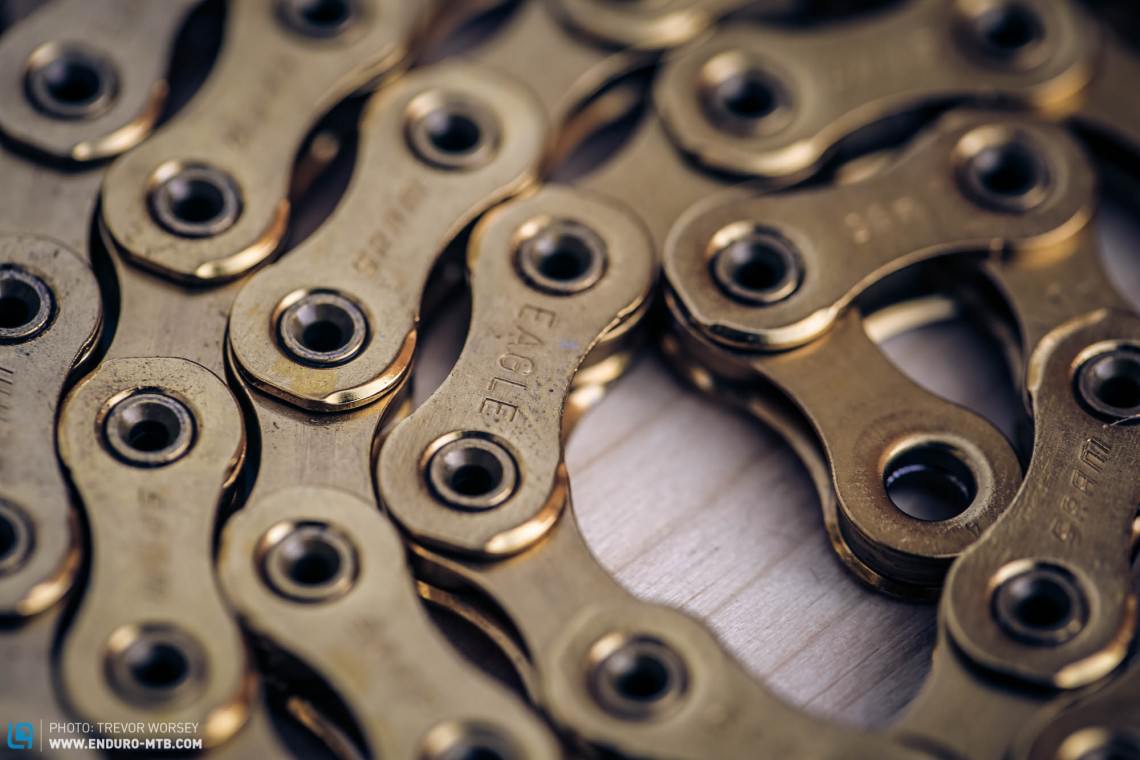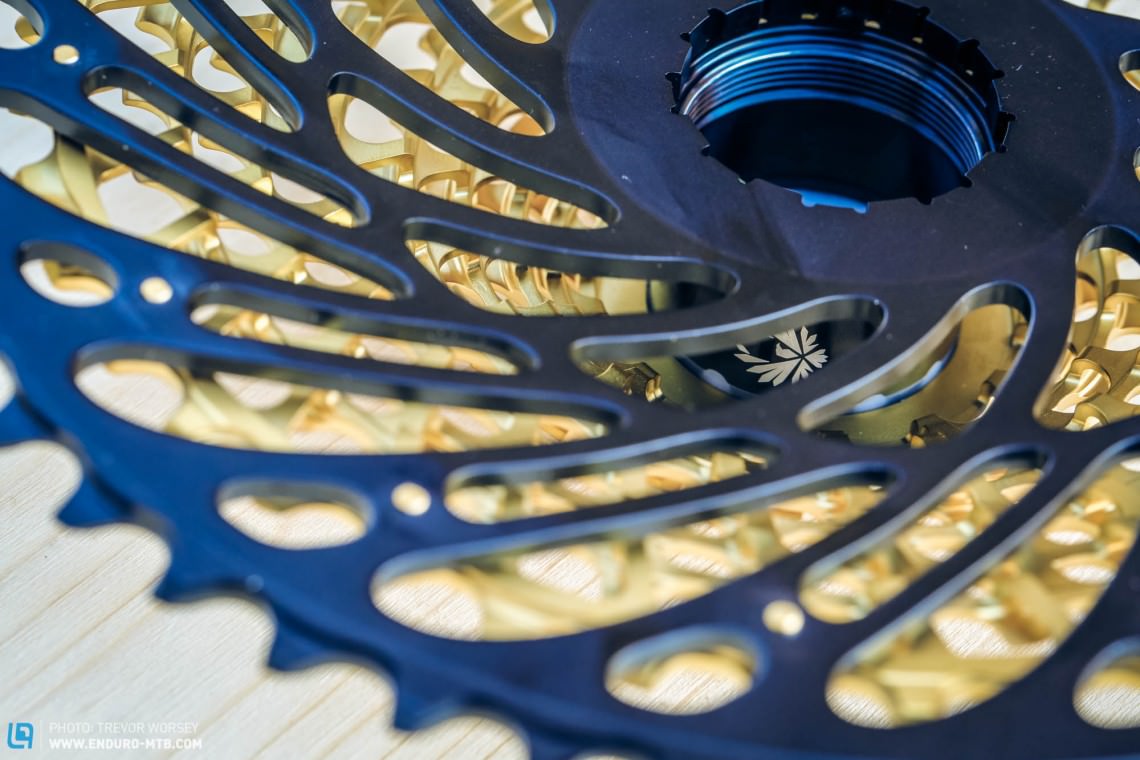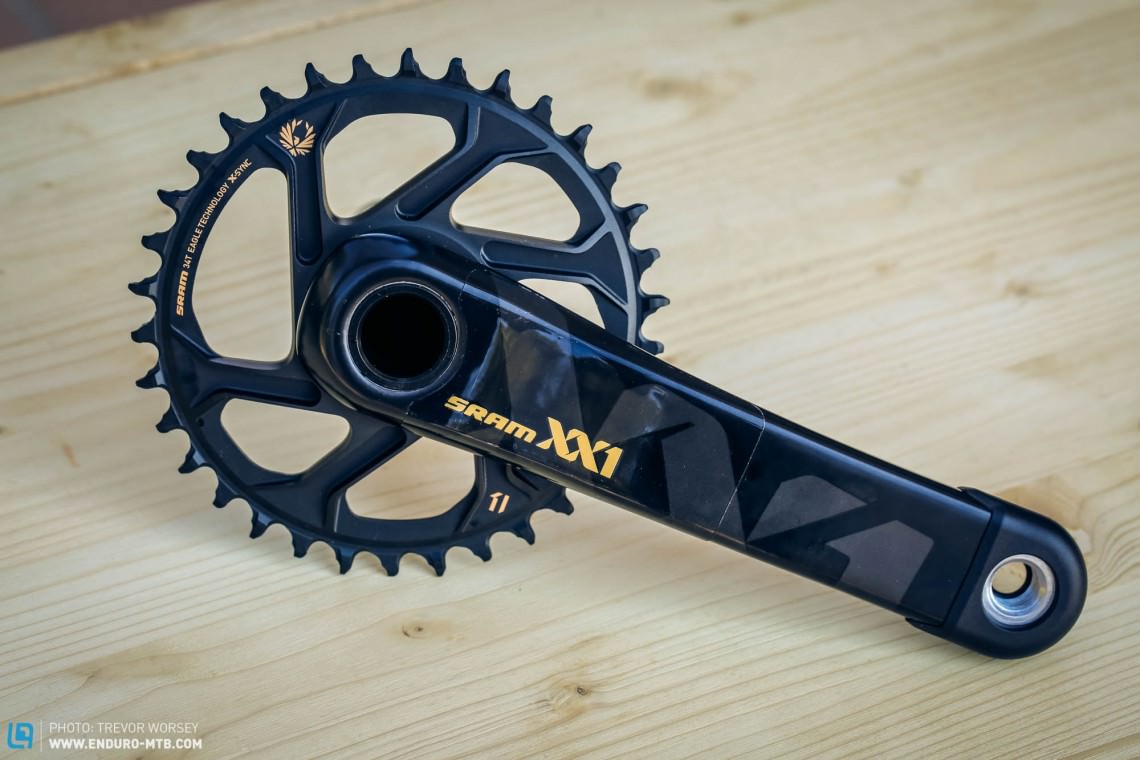The Eagle has landed, with 12 speeds and 50 teeth it’s sure to start the usual barrage of forum chatter, desire, excitement, confusion and probably hostility. We spent a few days riding the new 12 speed SRAM Eagle Drivetrain to bring you this ‘no bullshit’ guide to the golden drivetrain.
First up a quick history lesson, in 2012, SRAM introduced the world’s first purpose-built 1x drivetrain. Losing the front derailleur allowed us to remove a chunk of weight from our bikes, simplify our drivetrain and opened up new possibilities for frame designers. As soon as we went 1x all people cared about was range, you could even hear the conversations on the trail. “How big is that cassette sprocket? What! You’re only riding a 42 tooth? What the hell, you need to get a 44!“. With OneUp releasing the brilliantly named Shark 50 tooth step up ring, the battle of the big rings has begun. However, after a few days riding SRAM Eagle there is perhaps more to it than just a dinner plate sized cassette! We bring you 12 essentials to help you discover if SRAM Eagle is for you!
If you want to check out all the tech details, don’t miss our article: SRAM Eagle 12-speed Drivetrain announced: Weights, Prices, Facts.

1. SRAM Eagle is not just about range.
The first thing you notice is that huge cassette, it’s a whopper, and certainly everyone will be talking about Eagle’s 50 tooth cassette sprocket giving a huge 500% range. Do we really NEED such a huge range? Not really, with a correctly chosen chainring everyone from an elite athlete to amateur already has enough range with 1×11, buying Eagle just to get a few more gears would be missing the point. A 500% range will not revolutionise your riding but it is nice to have!

2. SRAM’s new FLOWLINK Chain is not the weakest link.
The difference between SRAM Eagle and 50 tooth step up rings is that it’s a ‘ground up’ redesign. SRAM owns their own chain factory in Portugal, where a surprising amount of tech goes into the highly complex chain. The 12 speed Eagle chain is entirely new, with rounded inner plates and totally flush pins that dramatically quieten the drivetrain. On the trail we noticed far quieter operation, especially in the outer extremes of the ratios.

3. SRAM Eagle is gold
This will be as good a reason as any for many riders to upgrade, it’s certainly a talking point. The XX1 Eagle Gold finish is actually a titanium nitride coating (the same as used on drill bits) and has proven extremely hard wearing in other applications. For those who want to stay out of limelight, the black cassette does not have the same finish and is less expensive.

4. SRAM’s Eagle has teeth
In efforts to boost durability, SRAM have developed new aggressive X-SYNC 2 teeth. When the older XX1 chainrings wear they are prone to ‘holding on’ to the chain at the bottom causing a rattling noise. The new X-SYNC-2 distributes load on more teeth to reduce wear (up to 4x in lab conditions) and the trailing edge has been removed to quieten release at the bottom of the stroke. SRAM are confident that their new Eagle ring has dramatically reduced hooking when it wears, keeping the drivetrain quieter for longer.

5. You don’t need new wheels to run Eagle
The new three piece 12 speed Eagle Cassette is wider than the older 11 speed model, but it can be fitted onto a conventional XD driver. This means you don’t have to change your wheels and do not need another axle standard! With decreased spacing between the gears (3.8 mm to 3.65 mm) and a narrower chain (5.6 mm to 5.25) the wider Eagle cassette is dished to make the most out of the available space. The derailleur does sit a little closer to the spokes in the biggest cog, but SRAM have tested it on all leading wheelsets.

6. Eagle has a new Type 3 Clutch Derailleur
The new rear mech does look bigger, and it is, a new larger 14 tooth lower jockey wheel means that SRAM has been able to introduce an increased clutch force for greater chain retention. The new clutch is 20% stronger than the old one, which cannot be felt on the trail, but what we could feel is that the shifting is still very light and fast.

7. The new chain is accompanied by a new Powerlock
Chains are only as strong as their weakest link, and the weakness has always been the power lock. Extreme shifting under load is never recommended, but Eagle has a new Power Lock with a firmer engagement to reduce breakages during multiple shifts to smaller rings while sprinting.

8. SRAM Eagle comes with a new chainring
Eagle is designed to be used as a system, you cannot run a current X-SYNC chainring with Eagle. However, the Eagle chain ring can be used on existing XX1-11 speed groups, bringing the advantages of the new teeth back to those existing group sets.

9. It’s bigger, but not too big!
The new rear derailleur has been redesigned and while it is a little longer than the XX1, it doesn’t protrude further down than Shimano XT. When the derailleur is at its lowest point it’s well protected by the wheel, but if you are a frequent rock striker it may be something to think about.

10. SRAM Eagle is easy to set up
The SRAM Eagle drivetrain comes with a simple tool to help set up the derailleur. Most home users set up their rear derailleurs B-tension up incorrectly (it should be set while sagged). Eagle has a simple tool that allows you to set up your derailleur easily for lightning shifts, (this tool will be rolled back to all 1x drivetrains)

11. No more de-synching
For those that have experienced that annoying de-synching (where the thick/thin teeth slip out of order) of the top pulley in muddy conditions, SRAM has removed the thick/thin teeth from the top pulley, smoothing shifting and improving performance in mud.

12. It’s a little heavier, but not a lot
The cassette is, of course, heavier, however the crank has been redesigned to save weight and overall the XX1 Eagle group set is only 50g heavier than XX1 11 speed, and still very similar to their biggest rivals. If you’re the sort of person who weighs your breakfast cereal, this may bother you, but for most, the increase in range and quieter operation will more than offset the small weight increase..

13. SRAM Eagle has the coolest name.
Yes, we know we said 12 reasons, but technology is moving so fast that there is sure to be a 13 speed by the time you get here! Our favourite thing about Eagle is the name, gone is the boring nomenclature, this is Eagle! Certainly the coolest name to hit a bike drivetrain, ever. Rumour has it that during the internal presentation to the sales teams, Chris Hilton simply talked about Eagles (the bird) for the first 20 minutes, much to the confusion of everyone. Next time someone asks you how many gears you have, you can just say “Eagle” and ride off screeching, flapping your outstretched arms.

Bottom line
Joking aside, now that the jump to 12 speed has been made there will be endless debate over ratios and speeds, but SRAM’s new Eagle technology is about more than that. It’s a holistic system designed from the ground up to take everything that made XX1 and XO1 so popular and make them even better. On the trail we experienced near silent operation with impeccably crisp and precise shifting up and down the block. The SRAM Eagle is set to be a sure-fire hit on the OEM and aftermarket, and we look forward to seeing if it’s durability impresses too. Oh, and did we mention it’s 12 speed?
If you want to check out all the tech details, don’t miss our article: SRAM Eagle 12-speed Drivetrain announced: Weights, Prices, Facts.
Words and photos: Trev Worsey
Did you enjoy this article? If so, we would be stoked if you decide to support us with a monthly contribution. By becoming a supporter of ENDURO, you will help secure a sustainable future for high-quality mountain bike journalism. Click here to learn more.









